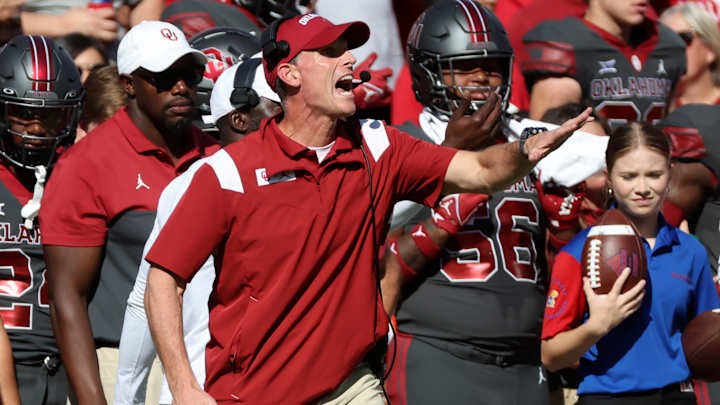Why Oklahoma's Brent Venables Says In-Helmet Communications Are 'Good for the Game'

In this story:
NORMAN — The dynamic of a college football sideline is likely going to look a bit different in 2024.
Last year, Michigan’s sign-stealing scandal dominated headlines across the sport, drawing many to call for the implementation of in-helmet communication devices, which are the norm on any NFL Sunday.
This offseason it appears advocates of the on-field communication devices are going to get their wish.
Earlier this month, Yahoo’s Ross Dellenger reported the NCAA Football Rules Committee is “moving closer” to rubber stamping those rule changes, an eventuality Brent Venables’ Oklahoma Sooners are preparing for this spring.
“They give every team in college football that's doing that — they're giving them all three headsets to use in the spring,” Venables said during a press conference on Wednesday.
It represents a change for OU, who declined to participate among the handful of bowl teams that piloted the technology last winter.
How Oklahoma Defensive Lineman David Stone has Built a "Support System" in Norman
The Alamo Bowl was not only Jackson Arnold’s first collegiate start, but it was Seth Littrell’s return to playcalling as Oklahoma’s co-offensive coordinator. Understandably, the Sooners were focused on keeping practice as normal as possible for Arnold, rather than throwing a new wrinkle into bowl practice by adding a radio into his helmet.
As high-tempo offenses spread across college football in the early 2000s, the various methods to quickly signal in plays became woven into the fabric of college football.
From poster boards with a seemingly random assortment of logos, objects and celebrities to backup quarterbacks and other staffers furiously running through hand signals in bold colors, how each program relayed the play calls onto the field became a unique quirk.
But even the implementation of the new communication system won’t instantaneously kill that aspect of the game.
“You're still gonna have to signal unless everybody decides they're gonna huddle,” Venables said. “There's no other way to get everybody the call. In the NFL you see a lot of huddles, both sides of the ball. You've got defensive huddles because the offense is over there huddling.”
Not every player on the field will have a helmet equipped with the technology.
Per Dellenger’s report, the committee is expected to adopt rules that only one member of each team can be equipped with the device on the field at once, and the radios will be cut off when the play clock ticks under 15 seconds, which are policies mirrored after the NFL’s rules.
Many are confident the new communications system will help curb sign-stealing, but Venables said you have to avoid pushing too much information through before the 15-second cutoff ahead of each play.
“It's a technology that's good for the game and you gotta be careful not trying to over-coach,” Venables said. “Sometimes you can over-coach. And just imagine the coach having the player come over to the sideline, right, 15 seconds before the snap and you tell 'em one last thing.”
As long as the technology is used wisely on Saturday’s, many like Texas coach Steve Sarkisian believe it can free time up during the week to better coach and prepare the team.
“I spend half my week changing signals and signs rather than coaching the game of football,” Sarkisian said last November.
The NFL is a much slower game. Most teams prefer to use a majority of the play clock to analyze the defense and make sure the play call and the offensive line protections are set up for success, leading to fewer snaps.
When the pads come on for the first time as spring practice gets underway in Norman next Monday, blending the new technology with the speed of the college game will be a new wrinkle for everyone, not just Oklahoma.
“Some ways we’re modeling it after the NFL, but our rosters are different,” Venables said. “The pace of the huddle in the NFL is much different. But we’ll manage all that and figure it all out.
“We’ll continue to find ways to be more efficient with your processes, your pre-snap. So I think it’s a good thing.”
- Follow AllSooners on Twitter to stay up to date on all the latest OU news!
- Want even more Sooners news? Check out the SI.com OU team page here!
- Listen and subscribe to the AllSooners Podcast!
- Watch more Sooners videos and subscribe on YouTube!
- Sign up for your premium membership to AllSooners.com today, and get access to the entire Fan Nation premium network!

Ryan is co-publisher at Sooners On SI and covers a number of sports in and around Norman and Oklahoma City. Working both as a journalist and a sports talk radio host, Ryan has covered the Oklahoma Sooners, the Oklahoma City Thunder, the United States Men’s National Soccer Team, the Oklahoma City Energy and more. Since 2019, Ryan has simultaneously pursued a career as both a writer and a sports talk radio host, working for the Flagship for Oklahoma sports, 107.7 The Franchise, as well as AllSooners.com. Ryan serves as a contributor to The Franchise’s website, TheFranchiseOK.com, which was recognized as having the “Best Website” in 2022 by the Oklahoma Association of Broadcasters. Ryan holds an associate’s degree in Journalism from Oklahoma City Community College in Oklahoma City, OK.
Follow _RyanChapman